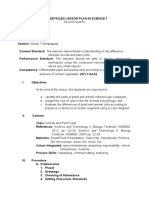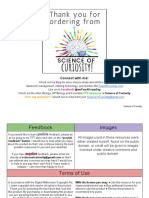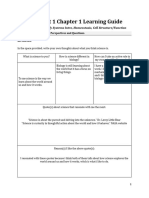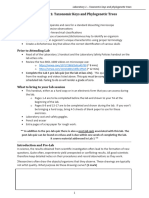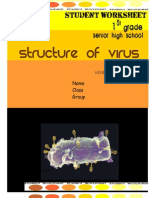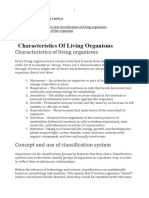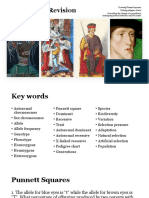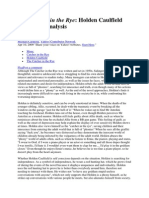What Is Life
What Is Life
Uploaded by
api-257659627Copyright:
Available Formats
What Is Life
What Is Life
Uploaded by
api-257659627Original Title
Copyright
Available Formats
Share this document
Did you find this document useful?
Is this content inappropriate?
Copyright:
Available Formats
What Is Life
What Is Life
Uploaded by
api-257659627Copyright:
Available Formats
Welcome Back!
Bellwork:
Please retrieve a pre-test from
the back and begin silently
working on it.
If you friends are trying to talk to
you: shush them!
Subject / Course: 7t h Gr ade Lif e Science
Learning Goal: SC.6.L.15.1: Analyze and descr ibe how and why or ganisms ar e classif ied accor ding t o
shar ed char act er ist ics wit h emphasis on t he Linnaean syst em combined wit h t he concept of
Domains.
Topic (Keywords): Classif icat ion
3.5 In addit ion t o scor e 3.0 per f or mance, in-dept h inf er ences and applicat ions wit h par t ial success
3.0
The st udent will:
Classif y or ganisms using a dichot omous key and f ield guide
Dist inguish bet ween t he t hr ee domains of lif e
Classif y or ganisms based on t he levels of classif icat ion
Descr ibe t he Scient i f ic Name of an or ganism
No major errors or omissions regarding t he score 3.0 cont ent (simple or
complex)
Explore and Explain
2.5 No major er r or s or omissions r egar ding 2.0 cont ent and par t ial knowledge of t he 3.0 cont ent
2.0
The st udent recognizes and describes specif ic t erminology such as:
Classif icat ion syst em
Domain
Binomial nomenclat ur e
Or ganisms
Pr okar yot e
Eukar yot e
The st udent will:
Explain char act er ist ics of living t hings
Be able t o descr ibe classif icat ion of or ganism
No major errors or omissions regarding t he simpler det ails and processes but
major errors or omissions regarding t he more complex ideas and processes
Engage
1.5
Par t ial knowledge of t he scor e 2.0 cont ent , but major er r or s or omissions r egar ding scor e
3.0 cont ent
1.0
Wit h help, a par t ial under st anding of some of t he simpler det ails and pr ocesses and some of t he
mor e complex ideas and pr ocesses.
0.5 Wit h help, a par t ial under st anding of t he scor e 2.0 cont ent , but not t he scor e 3.0 cont ent
0.0 Even wit h help, no under st anding or skill demonst r at ed
Lets see how we did!
You will grade your own quiz
You will use this number to decide
how well you know this material
Be honest with yourself. This is not
graded, it is so you can understand
where you are in your learning
Scale Tracking!
Use the scale tracking sheets at your desk
to decide where you are at in your
understanding of the content.
Reference the scale sheet to decide what
level you are at currently (I do not expect
you to be proficientyet)
Glue the tracking sheet into your
notebook
Time for Notes!
Take out your note taking
apparatus
Composition book or
Spiral or
Binder
Begin a new page titled: What
is Life?
Characteristics of Life
All living things share similar characteristics
These consist of:
1. Cellular organization
2. Contain chemicals
(like oxygen, hydrogen, etc.)
3. Use energy
4. Respond to surroundings
5. Grow and develop
6. Reproduce
Cellular Organization
All organisms (living things)
are made up tiny building
blocks called cells
The cell is the basic unit of
structure of living things
Some organisms are only one
cell, while others (like us) can
be made of trillions of cells
Unicellular Cells
Uni= one
Cellular = made of cells
Unicelluar = made of one cell
Most unicellular organisms are
bacteria. They only need one
cell to complete all functions
necessary for survival.
Multicellular Organisms
These types of organisms are
composed of many cells
Because there are so many, these
living things are more complex
Cells are specialized to do
different things
Ex. Skin cells protect you from
the outside while brain cells carry
information so you can make
decisions and carry out tasks
Is this picture of (a) unicellular or
multicellular organism(s)?
A.Unicellular because it has one cell
B.Unicellular because it is made of many cells
C.Multicellular because it has one cell
D.Multicellular because it is made of many
cells
Cells Contain Chemicals
Calls are made of different
chemicals
The most abundant chemical is water
Carbohydrates- the main energy source
Proteins and Lipids
Living Things Use Energy
Living things get energy from taking in
and breaking down materials.
This process is called metabolism.
Responds to Surroundings
All living things respond to the world
around them.
When a bright light flashes, or a breeze
rolls across your skin, your body and mind
react to this stimulus.
Even bacteria, plants
and fungus reacts to their
environment
Grows and Develops
Organisms are not
born and then
never grow,
everything grows
and develops!
Development is the
process of change
that occurs during
an organisms life.
Living things get energy from taking in
and breaking down materials. What is
this called?
A.Metamorphosis
B.Meta-analysis
C.Mariachi
D.Metabolism
When a chicken egg hatches and the
chick grows from being small to big,
this is called:
A.Enlargement
B.Development
C.Small to big
Reproduction
To produce offspring that is similar
or exactly the same as the parent.
2 Types:
1. Asexual
2. Sexual
Asexual Reproduction
A= not
SoAsexual is not
sexual reproduction
Only one parent is
needed and the offspring
is exactly the same as
the parent. There are
usually no boys and girls
for asexual species.
Sexual Reproduction
Two parents are needed to produce
offspring
The offspring share characteristics
from both parents
There are male and females
These types of organisms use _____
as a way of making offspring.
A.Asexual Reproduction
B.Sexual Reproduction
Where do Living Things Come
From?
Living things come from other living things
through reproduction
For a very long time people believed in the idea
of Spontaneous Generation
Where organisms simply appeared from nothing/ non-
living material
Lets read about it!
Page 321
You might also like
- Science: Quarter 4 - Module 2: Cell DivisionDocument21 pagesScience: Quarter 4 - Module 2: Cell DivisionAbegail Reyes85% (27)
- Documents For Discrimination ComplaintDocument2 pagesDocuments For Discrimination ComplaintJulian A.No ratings yet
- 7 Es SEMI DETAILED LESSON PLAN IN SCIENCE 7ESDocument8 pages7 Es SEMI DETAILED LESSON PLAN IN SCIENCE 7ESNeil Gabato100% (2)
- Rat DissectionDocument15 pagesRat Dissectionapi-233187566No ratings yet
- Connect With Me!: Have Any Questions?Document23 pagesConnect With Me!: Have Any Questions?Jennie Ann Sciarrotta BoudreauxNo ratings yet
- Mariko Mori and Takashi Murakami and The Crisis of Japanese Identity (Kristen Lambertson)Document81 pagesMariko Mori and Takashi Murakami and The Crisis of Japanese Identity (Kristen Lambertson)mariobogarinNo ratings yet
- Sex and The City S1 E2Document6 pagesSex and The City S1 E2luciasnmNo ratings yet
- SB 189Document87 pagesSB 189magicunicorndick50% (28)
- The Effects of PederastyDocument5 pagesThe Effects of Pederastyapi-270111486No ratings yet
- Chapter 1 ScienceDocument53 pagesChapter 1 ScienceAaron ChauNo ratings yet
- Biology and Our Environment: Learning OutcomesDocument30 pagesBiology and Our Environment: Learning OutcomesgiorgyaNo ratings yet
- Unit 1 Chapter 1 Learning Guide July 2023Document10 pagesUnit 1 Chapter 1 Learning Guide July 2023brodysewellNo ratings yet
- Answer Sheet: General Biology 1Document9 pagesAnswer Sheet: General Biology 1HanabiNo ratings yet
- Coursework Questions BiologyDocument6 pagesCoursework Questions Biologyvfbgttvcf100% (1)
- 5 Sep Plant CellDocument5 pages5 Sep Plant CellARCHIBALD S. SALANGSANGNo ratings yet
- Rat Packet PDFDocument15 pagesRat Packet PDFmajanga johnNo ratings yet
- Unit 1 Chapter 1 Learning Guide July 2023Document10 pagesUnit 1 Chapter 1 Learning Guide July 2023brodysewellNo ratings yet
- WEEK 1 - Theory - WorksheetDocument9 pagesWEEK 1 - Theory - WorksheetRajal PratapNo ratings yet
- Cell Processes Cheat SheetDocument3 pagesCell Processes Cheat SheetsarasNo ratings yet
- Science: Quarter 2-Hybrid Module 4 Plant and Animal Cells Week 4Document15 pagesScience: Quarter 2-Hybrid Module 4 Plant and Animal Cells Week 4Jannah SaladoNo ratings yet
- BIOLOGYDocument130 pagesBIOLOGYseny80439No ratings yet
- Cells and Microscope CompleteDocument57 pagesCells and Microscope CompletevinchyxyzNo ratings yet
- I.L. #3 - Plant vs. Animal Cells (Part I.)Document2 pagesI.L. #3 - Plant vs. Animal Cells (Part I.)montero.r.natalieNo ratings yet
- Observing Onion Cells.2015Document4 pagesObserving Onion Cells.2015Shaira LinalcosoNo ratings yet
- Tech LessonDocument5 pagesTech Lessonjfeur001No ratings yet
- Lab 1 BIOL1001 S24Document20 pagesLab 1 BIOL1001 S24King Hunter12No ratings yet
- Cell Parts HomeworkDocument4 pagesCell Parts Homeworkh45r84vq100% (1)
- Unit 1 Study Guide 2024Document28 pagesUnit 1 Study Guide 2024a.altouati.6025No ratings yet
- Biology NotesDocument159 pagesBiology NotesbasheerqawlaqNo ratings yet
- Science-8 Q4 W4Document22 pagesScience-8 Q4 W4Foracc MlNo ratings yet
- Workbook Bio1 - 2022-2 (Final)Document157 pagesWorkbook Bio1 - 2022-2 (Final)PersonalCLM2005No ratings yet
- Earth & Life Sciences (S11 - 12LT-IIa-1 and IIa-3)Document11 pagesEarth & Life Sciences (S11 - 12LT-IIa-1 and IIa-3)MD TristanNo ratings yet
- 6 Sep Animal CellDocument4 pages6 Sep Animal CellARCHIBALD S. SALANGSANGNo ratings yet
- Independent Ecology Study ProjectDocument5 pagesIndependent Ecology Study ProjectFelipe Riano FlorezNo ratings yet
- Virus WorksheetDocument8 pagesVirus WorksheetAnisa S. AlfianaNo ratings yet
- DLP G7Document18 pagesDLP G7Lyca SurbidaNo ratings yet
- 3 - CellsDocument14 pages3 - Cellswhat is upNo ratings yet
- Q2 Module 1Document24 pagesQ2 Module 1klokil byeNo ratings yet
- Biology NotesbookletDocument115 pagesBiology Notesbookletm.umar.saiyedNo ratings yet
- General Biology 1: Learning Activity Sheet 1 The Origin of LifeDocument5 pagesGeneral Biology 1: Learning Activity Sheet 1 The Origin of LifeZoriah BianoNo ratings yet
- BIOTECHNOLOGY Module-3 - MQADocument35 pagesBIOTECHNOLOGY Module-3 - MQAPrincess Zhaira Mae TañoNo ratings yet
- All About CellsDocument44 pagesAll About CellsRizahNo ratings yet
- Unit 1 Chapter 1 Learning Guide July 2023Document10 pagesUnit 1 Chapter 1 Learning Guide July 2023brodysewellNo ratings yet
- Cells Homework Ks3Document5 pagesCells Homework Ks3erdy4162100% (1)
- Examining Plant Cells (Elodea)Document5 pagesExamining Plant Cells (Elodea)Jun Rey DequinaNo ratings yet
- Biotech Module 1 1Document49 pagesBiotech Module 1 1Janine CallanganNo ratings yet
- As BiologyDocument127 pagesAs BiologyRob Gomez100% (7)
- Grade 12 LM General Biology 1 Module1Document13 pagesGrade 12 LM General Biology 1 Module1altheajade jabanNo ratings yet
- BIOLOGY1 - Q1 - Module 2 - Structure and Function of OrganellesDocument10 pagesBIOLOGY1 - Q1 - Module 2 - Structure and Function of OrganellesSeul AsterNo ratings yet
- Unit Plan - The CellDocument13 pagesUnit Plan - The Cellapi-285097559No ratings yet
- Stem Gbio1 Q1W1Document10 pagesStem Gbio1 Q1W1Yoi MiyaNo ratings yet
- Science7 Q2 Mod4 EggsAreWhiteLemonsAreYellowLikeMeAndYouTheyreMadeOfCellsToo V3.1 TessOKDocument34 pagesScience7 Q2 Mod4 EggsAreWhiteLemonsAreYellowLikeMeAndYouTheyreMadeOfCellsToo V3.1 TessOKEspher Macabitas100% (6)
- A General Biology I Q1M1.1Document24 pagesA General Biology I Q1M1.1Queng ElediaNo ratings yet
- Characteristic of Life - Characteristic of LifeDocument7 pagesCharacteristic of Life - Characteristic of LifeMary L. GarvillesNo ratings yet
- Mid Term Study Guide For 2022 Without EcologyDocument8 pagesMid Term Study Guide For 2022 Without EcologyAniya HarriottNo ratings yet
- Q3 Week 5 Stem G11 General Biology 1Document23 pagesQ3 Week 5 Stem G11 General Biology 1John Benedict MaurilloNo ratings yet
- 2.act. Cell Parts and FunctionsDocument3 pages2.act. Cell Parts and Functionssamsung picturesNo ratings yet
- BIO IGCSE NOTES - Copy-1Document9 pagesBIO IGCSE NOTES - Copy-1diegocmakoNo ratings yet
- Q1 W1 M1 Biotechnology SSElectiveDocument20 pagesQ1 W1 M1 Biotechnology SSElectiveJohn Lord Jay D. SayconNo ratings yet
- Uncovering Student Ideas in Science, Volume 1: 25 Formative Assessment ProbesFrom EverandUncovering Student Ideas in Science, Volume 1: 25 Formative Assessment ProbesNo ratings yet
- Sex Outside MarriageDocument15 pagesSex Outside MarriageTimmons GwenNo ratings yet
- People vs. CaoiliDocument51 pagesPeople vs. CaoiliRomy Ian LimNo ratings yet
- Girls' School PetDocument61 pagesGirls' School PetPedro TorresNo ratings yet
- How To Effectively Seduce Married Women Into BedDocument11 pagesHow To Effectively Seduce Married Women Into BedGabriel MedinaNo ratings yet
- Girl Bi Bakla Tomboy The Intersectionality of Sexuality Gender and Class in Urban Poor ConteDocument30 pagesGirl Bi Bakla Tomboy The Intersectionality of Sexuality Gender and Class in Urban Poor ConteMark Anthony NalapoNo ratings yet
- Moot CourtDocument36 pagesMoot CourtAnubhutiVarma75% (4)
- Biology Test RevisionDocument13 pagesBiology Test RevisionRalph Rezin MooreNo ratings yet
- Mahabharata: Table of ContentsDocument17 pagesMahabharata: Table of ContentsvanitaNo ratings yet
- crowley2009 - вагинизмDocument6 pagescrowley2009 - вагинизмxobekon323No ratings yet
- Fighting Child Abuse in The PhilippinesDocument15 pagesFighting Child Abuse in The PhilippinesMarvin Casey CrisostomoNo ratings yet
- Under His SpellDocument173 pagesUnder His SpellLiz Davis33% (3)
- Prince, Miles, and Maceo - Horns, Masculinity, and The Anxiety of InfluenceDocument35 pagesPrince, Miles, and Maceo - Horns, Masculinity, and The Anxiety of InfluenceDomino D'LorionNo ratings yet
- Debate Sex Ed - CSPDocument4 pagesDebate Sex Ed - CSPYzavelle PanganibanNo ratings yet
- Position PapersDocument3 pagesPosition PapersJennifer TinaganNo ratings yet
- (2.) People vs. Flores (DIgest)Document2 pages(2.) People vs. Flores (DIgest)Obin Tambasacan BaggayanNo ratings yet
- Toulmin Argument Essay PDFDocument7 pagesToulmin Argument Essay PDFynottripNo ratings yet
- A Study of Power in Robert Browning's Porphyria's LoverDocument13 pagesA Study of Power in Robert Browning's Porphyria's Loverpachara_niranNo ratings yet
- Depo ProveraDocument3 pagesDepo ProveraNadine Abdel-GhafarNo ratings yet
- The Catcher in The RyeDocument3 pagesThe Catcher in The RyeHodžić NisvetaNo ratings yet
- MCQs Obs & GynaeDocument7 pagesMCQs Obs & GynaeSaima Kanwal100% (2)
- Jane Eyre From Governess To Girl BrideDocument19 pagesJane Eyre From Governess To Girl BrideLubomír LužaNo ratings yet
- News Articles 40Document25 pagesNews Articles 40alan_mockNo ratings yet
- My Beautiful RoommateDocument193 pagesMy Beautiful RoommateGabriela Tifany Rakian100% (1)
- AgagDocument111 pagesAgagamry_233No ratings yet
- Class 7 Science Chapter Reproduction in PlantsDocument37 pagesClass 7 Science Chapter Reproduction in PlantsUjjal BhattacharjeeNo ratings yet


